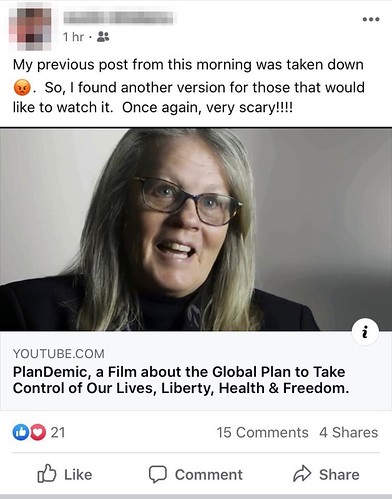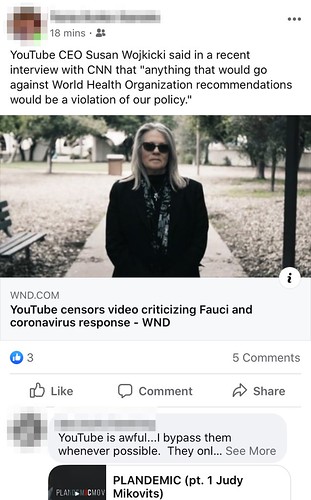All of us using the Internet today, regardless of age or past education credentials, need additional media literacy skills in our present age of “information pollution” and the neo-coronavirus pandemic. This past week, large numbers of people on social media shared video links to a purported “documentary” titled “Plandemic” which allegedly reveals “the hidden agenda behind COVID-19.” In this post, I’d like explain why the sharing of this video provides a “teachable moment” and case study for us all. It highlights not only the prevalence of disinformation and conspiracy theories in our media landscape, but also the important responsibility we each bear to vet information sources before we share links. It also spotlights ways we should consider how our actions affect and influence others, both online and offline. Among other strategies and suggestions, I want to amplify Mike Caufield’s (@holden) SIFT framework (the 4 moves) as a practical media literacy strategy we can each practice and also share with those with whom we have digital contact. Mike’s latest project, the infodemic.blog, includes practical tips we can immediately put into practice whether or not we’re currently classroom teachers.
Before sharing the story of how I first learned about this “PlanDemic” video last Wednesday evening, which has now been “thoroughly debunked” by multiple credible, trustworthy sources, I want to emphasize the importance of figuring out individually how we deal with situations like this. Joe Pinsker (@jpinsk), writing for The Atlantic, suggests a variety of strategies to employ when someone you know and are connected to on social media shares this specific video link or another one like it. I want to add to Joe’s list of suggestions that we DO engage with, and do not ignore, friends and colleagues who share disinformation, misinformation, or malinformation. Of course situations and contexts necessitate different responses… and a valid response could be to unfollow and/or block someone on social media who is a dedicated conspiracy theory and disinformation link sharer. However, other more potentially constructive interaction options exist. The common themes I want to recommend involve encouragement to employ critical thinking, media literacy strategies, and source / information vetting. Above all, whenever we read something online which immediately starts to trigger an emotional response, we need to invoke the “S” step (STOP) of the SIFT framework. By “stopping,” we can take time to invoke the other tools in the SIFT framework, think more critically, and increase the chances we can constructively add to the maelstrom of shared information online today rather than harmfully contribute.
Shortly before our weekly webshow started last Wednesday, I saw the following Facebook post from a friend and fellow member of our church. I’m obscuring his name and avatar, because my intent here is decidedly NOT to call out or embarrass this person by name… but rather, to constructively engage with a situation we are all facing to varying degrees today, depending on who we follow online. As you can see, this person was sharing a YouTube link to the “PlanDemic” video.

“Plandemic Disinformation Teachable Moment” (CC BY 2.0) by Wesley Fryer
As referenced in that original post, the same person had posted ANOTHER link to the PlanDemic video in the morning, ten hours earlier, but was frustrated that YouTube had taken down first video. As an apparent “public information service” to those who follow him online, he was posting another copy. In both cases, the main emphasis of his posts were, “This is scary.”

“Plandemic Disinformation Teachable Momen” (CC BY 2.0) by Wesley Fryer
I’d like to observe as a follower of Jesus Christ and a member of the same church as the individual who shared this post, we should specifically aspire NOT to scare people and increase their fear as Christians. Fear is not a spiritual gift. In fact, fear is one thing “the enemy” encourages us experience in our hearts and minds. As followers of Jesus, we are encouraged to explicitly NOT be anxious and fearful, but rather bring our worries and concerns to the feet of God’s Son so He can deal with everything for us. It is explicitly contrary to the Biblical teachings of Jesus Christ to tell others, “Be scared, be very, very scared.”
The second thing I want to observe about this situation is how shocked I was that this person I know shared these video links. I actually searched Google News before our EdTechSR show on Wednesday night for the word “PlanDemic,” to see if I could share a link to a journalist’s review and analysis of the video, but no articles were listed yet. The speed of social media, when it comes to situations like this, is viral. Today (3 days later) PlanDemic is a topic on Google News and now there are a wide variety of articles addressing and debunking the messages as well as the “expert voices” it features.
For me, this situation highlights how important and critical our societal need for greater media literacy is. Unfortunately, we live in extremely polarized times, but the tools employed by some to polarize and emotionally incite others can also be used to fact check, compare, “shine light on,” and expose the truth. That’s exactly what the SIFT framework and “The Four Moves” encourage us to do as literate web users.
Searching for a web source on WikiPedia is an excellent step to take after STOPPING to investigate a web link further before sharing it with others. Earlier last week, another friend (this one a classmate from the U.S. Air Force Academy who I follow on Facebook) shared an article about YouTube’s disinformation censorship policies and the World Health Organization.

“Plandemic Disinformation Teachable Momen” (CC BY 2.0) by Wesley Fryer
It turns out, the statement she shared in that post IS accurate. Episode 4 of the “Rabbit Hole” podcast from the New York Times includes interviews with Susan Wojcicki, and she confirms that non-WHO conforming video messages about COVID-19 are now censored from the platform.
I commented to my friend on this post, however, before even looking at the content of the article, it’s important to look at the source, and shared the link to the English WikiPedia page about the hosting website. It’s an extreme website which regularly shares far-right and alt-right conspiracy theories. I encouraged my friend to check if other mainstream media sources are sharing the same information too, which is the “news search cross check” step of SIFT. Shortly after I posted my first comment on that Facebook post, I tried to comment again, but I couldn’t because my friend had deleted the original post.
It’s also ironic (but in the entire context of this post, understandable) that the first commenter on my friend’s original (and now deleted post) was sharing a link to the “PlanDemic” video, even as s/he also decried YouTube as a terrible information source to be avoided at all costs.
We shouldn’t be naive or overly optimistic about our potential abilities to shift the thinking of others with our replies and posts to social media. Directly engaging with someone who is sharing disinformation / misinformation / malinformation is fraught with challenges. Will we make that person angry? Will we invite others to be angry at us? Can we engage in a constructive conversation? Can we promote critical thinking and better media literacy through kind and respectful dialog, when so many people around us are shouting and condemning? It’s a messy, tricky situation… but it’s one from which we should not retreat as citizens concerned about our democracy and our society writ large.
If you enjoyed this post and found it useful, consider subscribing to Wes’ free, weekly newsletter. Generally Wes shares a new edition on Monday mornings, and it includes a TIP, a TOOL, a TEXT (article to read) and a TUTORIAL video. You can also check out past editions of Wes’ newsletter online free!
Did you know Wes has published several eBooks and “eBook singles?” 1 of them is available free! Check them out! Also visit Wes’ subscription-based tutorial VIDEO library supporting technology integrating teachers worldwide!
MORE WAYS TO LEARN WITH WES: Do you use a smartphone or tablet? Subscribe to Wes’ free magazine “iReading” on Flipboard! Follow Dr. Wesley Fryer on Twitter (@wfryer), Facebook and Google+. Also “like” Wes’ Facebook page for “Speed of Creativity Learning”. Don’t miss Wesley’s latest technology integration project, “Show With Media: What Do You Want to CREATE Today?”
Source : “PlanDemic” Disinformation Teachable Moment During COVID-19









